























































Understanding the unique health needs of our communities is our business. At University of Maryland ShoreRegional Health, we makesurethe health careyou need is right here, close to home.Our network of physicians and providers work side-by-side with University of Maryland School of Medicine specialists to bring ahigherlevel of expertise directly to the communities we serveacrossthe Eastern Shore. When you see aShoreRegional Health sign, it’s our promise forcreatinghealthier communities together.You don’t need to travel farfor advanced carewitha personal touch. It’s hereinyour ownbackyard,asithas been formorethan acentury
To findaphysician or serviceclose to home,visit umshoreregional.org





























Dec. 1 1st Saturdays - Cookie Walk
Downtown Stevensville 1-5pm
Holiday Concer t Historic Christ Church 5pm Tree Lighting Downtown Stevensville 6pm
QAC Chorale “Peace on Ear th” Chesapeake College TPAC 7pm
Dec. 1, 2, 8, 9 Festival of Trains Kent Narrows Outlet Stores 1-5pm
Dec 5 Tree Lighting Centreville 6:30pm
Dec. 7 Holiday Parade (rain date 12/14) Centreville 6:30pm












Dec. 8 Holiday Cheer Christmas Bazaar KI High School 11- 3pm
Heck with the Malls Ar tisans’ Sale QAC Centre of the Ar ts 10-3pm
Holiday Candlelight Tour of Historic Homes Centreville 1-6pm





2nd Saturdays at Bull & Goat Brewery & Bay Shore Steam Pot Centreville Noon - 4pm
Dec. 14 Stefan Scaggiari Coffee House Holiday Concer t QAC Centre for the Ar ts 7-9pm
Dec 16 Lessons & Carols St. Paul’s Church 10am











































Each year, sometime between Thanksgiving and the first week of December, my mother calls me when she hears Elvis Presley’s “Blue Christmas.”

To her, it signals the official beginning of the Christmas season, sort of a secular, pop-culture Advent. It does not count if she plays the song on purpose; she must hear it in the wild.
When she calls me to announce the arrival of the season, she does not say, “hello.” She simply begins singing in her best Elvis voice as soon as I answer the phone.
My favorite traditions involve funny memories and laughter. For example, I love recalling how my grandfather, whose memory was faltering, sang “Maurice la-de-da” to the tune of “Feliz Navidad” and how sweet Santa was to my then-one-year-old twins who screamed in his lap when I walked away for a moment.
I’ve been thinking a lot about tradition in the past few months, the meaning we derive from ritual, the connection we feel to our ancestors when we light the Shabbat candles, take Communion, or pray toward Mecca.
Our yuletide traditions, whether secular or religious, connect us to those we love, the people who have gone before us, and strangers who share similar rituals across the world.
I hope you will partake this December of the best traditions shared across cultures and religions –charity, family, friendship and peace.
Sarah Ensor Editor
EDITOR
Sarah Ensor
CREATIVE DIRECTOR
Greg Mueller
CONTRIBUTING PHOTOGRAPHERS
Arden Haley
Caroline J. Phillips
Jameson Harrington
CONTRIBUTING WRITERS
Amelia Blades Steward
Caroline J. Phillips
Jennie Burke
Jerisha Parker Gordon
Reen Waterman
EDITORIAL CONTACT
410-463-9883
PRESIDENT/PUBLISHER
David Fike
MARKETING DIRECTOR
Betsy Griffin
REGIONAL SALES MANAGER
Art Crofoot
NEW MEDIA MANAGER
Paul Hagood
ACCOUNT EXECUTIVES
Jon Ekroos
Frank Gunsallus
ADVERTISING CONTACT
443-239-0307
SUBSCRIPTIONS
410-770-4005
Receive ShoreMonthly in the comfort of your own home for only $24 a year, or subscribe to The Star Democrat for $138 a year and receive ShoreMonthly for FREE.
SUBMISSIONS submissions@ shoremonthly.com

No portion may be
in whole or in part by any means, including electronic retrieval systems, without written permission from the publisher.



































































*Pet feeand sizelimits mayapply.See Sales Director fordetails.
www.HeartFieldsAssistedLivingAtEaston.com


Story by Jennie Burke | Photos by Caroline J. Phillips
My father, Hamish Osborne, was a man’s man. Here’s an incomplete list of some of his favorite manly pursuits, minus the ones that got him in trouble: golf, boating, poker (sometimes bridge or gin rummy), hunting dogs, fishing, skeet, old cars, westerns and war movies, the New York Times cross -

word puzzle, reading by the fire in a leather recliner, and falling asleep in front of the television while balancing a tumbler of scotch on his chest. Also, he could tie the stem of a maraschino cherry with his tongue and balance a teaspoon on his nose. It gave him something to do while the rest of us were rambling on and being ridiculous at the table. He was a proud and patriotic Eastern Shore conservative. I am the product of Title 9 and spent the early years of my career as a public-school teacher. We had many differences; my mother

used to call us Oil and Water when we had one of our debates. I would retort: “We’re oil and oil Mom! Stubborn and the same, just from different generations.” Dad and I loved spending time together just the two of us. We usually did this over food, drinks or sporting events.
Dad’s season tickets at Camden Yards were in the section tended by famed Beer Man Clarence “Fancy Clancy” Haskett. I’m not much of a beer drinker, but it sure tasted good to wash down peanuts on a humid summer night with a cold one from Clancy. The only time I ever liked beer was at the ballpark with Dad.
We celebrated our June birthdays and Father’s Day by heading out for a fancy lunch. We feasted on briny Choptanks and Chinquatagues and sipped cold Muscadet wine. They only time I ever liked white wine was while eating oysters with Dad. And I never, ever liked eggnog, but I did, and do, love The Recipe, Dad’s homemade version of the holiday tipple. It’s a hybrid cocktail and dessert. Everyone loves it. Even eggnog haters. Come December, right around tailgate prep time for the Army vs. Navy game, my father turned our kitchen into his laboratory. The lethal fumes of dark rum and cognac, combined with the
incessant clatter of electric beaters, indicated that my mother had given Dad brief reign over her domain. Once the batches were made and bottled (and the counters, floors and walls thoroughly scrubbed), Mom added shiny bows. My brothers delivered the hooch to neighbors we loved or had offended.
There was only one problem with The Recipe: everyone wanted to know how to make it, but Dad refused to share. The idea of a secret recipe may sound romantic, but it’s painful for an empath like me. I knew how to make it. I shared the beverage with friends, and when they asked for the
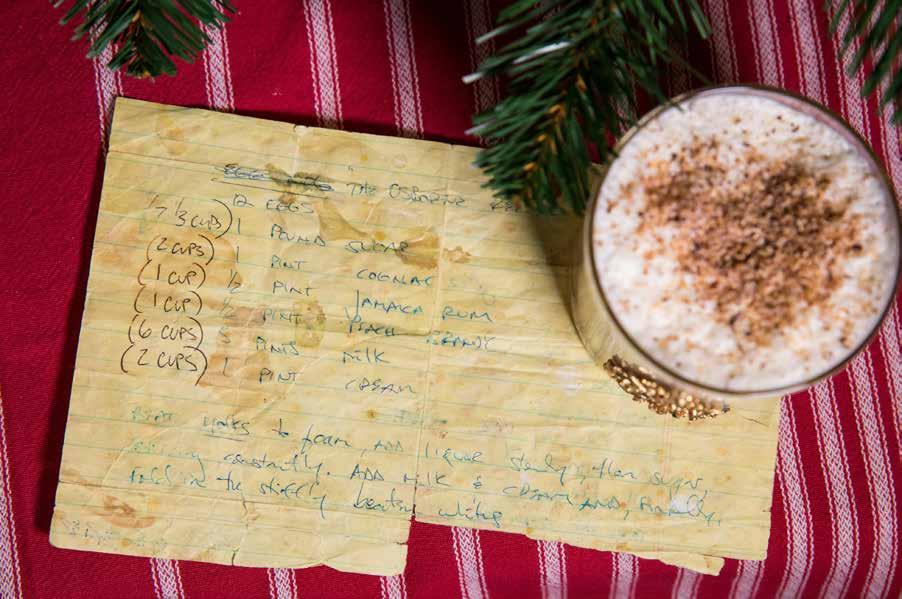
recipe for The Recipe, I could only reply, “I wish I could tell you. It’s a secret.”
One awful year, in 2005, I shared the recipe unintentionally. My husband and I had left a town we loved (New Orleans) for a new job. In July, my best friend, Holly Jean Fitzpatrick, passed away after a five-year battle against cancer. In August, Hurricane Katrina rolled over New Orleans and destroyed the homes of many of our loved ones. We welcomed our fourth child in five years (no twins) in September.
We had no family or friends in our new town and didn’t have the time or energy that the pursuit of
authentic friendship requires. But like a glorious promise, or an encouraging pat on the back, the universe sent new friends to us.
Jill Shiflet showed up on my doorstep with a meal after I had the baby. Then she invited me to join her carpool. I knew I had a keeper for life when I met Jill. Our husbands became friends too.
One December Saturday I stopped by the liquor store and loaded up on Jamaica Rum, Courvoisier (not cognac; Courvoisier), and peach brandy (any brand will do). The Shiflets had invited our family over for dinner, and we were going to show them how to make The Recipe. We had a terrific
time together in the kitchen. Jill and Mark were astonished at the ungodly amount of booze that one batch required. The kids ran wild, and we sang and listened to music, ate chili, and felt grateful for the background noise of holiday-frenzied children.
Mike instructed Mark how to stir, gently, then fold (“FOLD Mark! Stop STIRRING!”) the egg whites. We savored those joyful moments at the end of a terrible year. My heart was unburdened when I set the recipe free. It was the least I could do for a friend who had saved me.
The next day, after a breakfast of bacon, Gatorade and Advil, I

The idea of a secret recipe may sound romantic, but it’s painful for an empath like me. I knew how to make it. I shared the beverage with friends, and when they asked for the recipe for The Recipe, I could only reply, “I wish I could tell you. It’s a secret.”
called my father to admit the crime.
“Oh hey, Jen! That’s no big deal! I hope your friends enjoyed it.”
WHAT?
“I’ve shared it from time to time myself.”

2016 was a hard year, too. Besides the divisive election, my life was consumed by a circus of four healthy teens: school, sports, music, friends, repeat. And my fierce father died young, following terminal illness.
My father’s death robbed me of a gift: the trust of someone who thought differently than I did. He made sense of the impossible for me. He could deliver me from hopelessness to optimism, regardless of the situation. When we disagreed, as we often did, we dissected our chosen values from behind home plate, where we sat behind Tim Russert and flagged down Clancy; or at a table for two, waiting for another dozen oysters. He was irreplaceable in times of uncertainty. I had but one father, and I won’t know him again in this world. I can’t imagine a time that this reality won’t crush me, not even if I grow to be 100 years old. But, if I refuse to celebrate the moments, the hard ones and the good ones, the ones where I have no understanding of humanity, and the ones that leave me breathless with wonder, then I fail my father’s legacy.
We are born to forge ahead, while we carry an inheritance of the heart. The Recipe tastes the same, but it feels different. It’s still comforting. But it’s complex, too. In the past two Christmases I’ve found the courage, (liquid courage, Dad called it) to sneak into our living room all alone for momentary respite from yuletide chaos and face what is missing. Glittering tree before me, heavy glass in hand, I offer a toast to what I had, what I am building, and to the man I cannot see. I look out and up, into the into deepest night and whisper, “I’m gonna make it, Dad. I’m still here.” And he is too.

by the late Hamish Osborne
12 eggs, separated 2 1/3 cups superfine sugar
2 cups Courvoisier
1 cup Meyer’s dark rum
1 cup peach brandy
6 cups whole milk
2 cups cream
Freshly ground nutmeg
In a large bowl, beat the egg yolks until foamy. Combine liquors and add in a slow pour, while stirring slowly. Add sugar, again stirring constantly. Add milk and cream. Stir.
In another bowl, beat the egg whites until stiff peaks form. Gently fold egg whites into egg yolk mixture. Ladle into cups and top with freshly ground nutmeg.


The interesting origins of one of Maryland’s most elusive mammals

Sika deer have proved to be an attractive game animal, and hunters from far and wide come to the Shore in search of a sixpoint (or better) stag. Guide services cater exclusively to sika hunters and in the past several years national hunting shows have featured the hunt for our marsh ghost.
Driving through the local marshes of Dorchester County at dusk, you may have spotted one of the Eastern Shore’s unique game animals. In your attempt to identify it, you first think it’s too small to be the commonly seen whitetail deer. Yet, on second glance you are sure it’s a deer.
“What is it?” you wonder.
You have just experienced a sighting of the “marsh ghost.” Sika deer (cervus nippon), actually a small member of the Elk family, originates from Yakushima Island in southern Japan. The term “sika” comes from the Japanese word for deer, “shika.” Sika deer are also called sika elk, Asian elk, or the “marsh ghost” by avid hunters.
Because of their hardy nature and ability to eat a broad range of plants, leaves and crops, sika deer have been introduced around the world, in places such as Vietnam, Russia, Europe and the United States (Maryland, Virginia, and Texas).
In 1916 Clement Henry released six sika deer (believed to have come from Europe) on the Choptank River’s James Island. Around the same time, Dr. Charles Law released sika deer on Assateague Island. Today, the Maryland herd is the largest free-ranging herd in the United States, with somewhere between 10,000 and 15,000 members.
Most of the Maryland population is found in Dorchester, Wicomico, Somerset and Worcester Counties. Caroline County has a growing resident population, and there have been a few reported sightings of stags in Queen Anne’s County. It is interesting to note that the Virginia and Maryland herds do not mix.
Brian Eyler, deer project section leader for the Maryland Department of Natural Resources, said, “Sika deer, while an exotic species, are not an invasive species. When the sika were first released, we had a very limited whitetail population. The sika naturally occupied terrain and food sources that best fit their needs.
“As the whitetail population rebounded in the 1960s and 1970s, they [inhabited] areas and food sources that best fit them ... so there never has been a competition between species. We simply manage an exotic species as if it were native.”
While whitetails are known for their fondness of corn, soybeans and acorns, the diminutive sika prefers a more varied diet. Favorite foods for sika are marsh grass, bayberry, catbrier and poison ivy.
“While whitetails and sika [habitate] similar territory, whitetails tend to stick more to agricultural croplands while sika stick to marsh and wet woodlands,” Eyler said. “They prefer different food sources. And, being of vastly different sizes, interbreeding is highly unlikely. They are too far apart on the family tree to crossbreed.”
Sika are most often seen at dawn and dusk and are not as easy to pattern as whitetails. They are considerably smaller than whitetail and have dark brown or black coats in winter and a reddish orange coat in summer. Sika females, called “hinds,” have white spots, which they keep as adults, and are more prominent in the summer. Sika males, called “stags,” can average 75 pounds field-dressed, while hinds tend to average 50 pounds.
Sika travel in herds more than whitetail deer do, and young sika are called “calves.” A sika bugle is a high-pitch shrieking heard during the “rut,” or mating season. During the rut, stags keep a harem of estrous hinds in close proximity, and fiercely protect them against all rivals.
Sika hinds typically bear a single calf, whereas a whitetail doe may have twins or triplets. Sika tend to outlive whitetails, mainly due to their withdrawn and more nocturnal marshland lifestyle.
Like their larger cousin the elk, sika make “mud wallows.” They lie in these mud pools to protect themselves from the bug population, causing them to favor the heavily marshy areas along river corridors.
Being a non-native species, sika have several decided advantages over whitetails. In addition to not being tied to limited food sources, sika are more resistant to diseases such as chronic wasting disease. They also are more resistant to mosquito-borne diseases. Their small size and weight allow them to navigate the marshlands with the ease of a hummingbird in places a whitetail would never dream of traveling.
Whether your interest is photography, observing wildlife or hunting, sika can be tricky to find. They stay in the deepest recesses of hardto-reach marshland. Those seeking them should remember to take bug spray.


A recent Maryland DNR study found that 3,000 to 5,000 hunters hunt for sika deer, spending more than 30,000 hunter days in the field.

In 2017, 3,150 Sika were harvested, including 1,423 stags and 1,727 hinds.

An expanded turkey and sika deer population has allowed land owners to command more for hunting leases. Photos submitted by sikastag.com





































Startenjoyingthe lifestyleyou’vealwaysdreamed of at Londonderryonthe Tred Avon today!

As ar esi dent of theE ast ern Shore’ so nl y6 2+ ind epend ent livi ng cooperative, you can enjoy all the benefits of home ownership without acarefor maintenance or upkeep. Limited opportunities for apartments and homes still available. Come visit us in our brand new Clubhouse. Now’sthe perfecttime to takeawalkon our beautiful waterfrontcampus and enjoy our vibrant,active community. Whywait?The besttime to visit us is today! Call Rachel Smith at 410-820-8732 to find out how you can start living Your Life, Your Way today!











Each year during our holiday feasts my father does the blessing. He starts with the standard blessing of the food to our bodies, but then moves into something that is possibly unique to just afamily of undertakers. He asks for aspecial blessing of healing to all the families we assisted that year.You see my father has always built his undertaking business around the fact that we help families heal. For the countless number of individuals my family has assisted through the years, we can’t help but simply take asmall moment to remember them and the members of the family left behind. Memorializing aloss is something that we see each and ever yday.Statues, monuments and even lights are put in place today to help remember aloss incurred as afamily and/or anation. But when it comes to the holiday season, it also makes things that are different from years past ver yapparent, and memories are sometimes all we have to hold on to. What we need to explore is the memorization of the individual so that memories can be shared for future generations.
One concept we see families incorporate during the holiday season to memorialize someone is that of simply keeping them apart of the event. For example, during the big Turkey Day feast, set aplace for the one that was lost that year.And then have people share a stor yormemor yabout that individual regarding how they touched them. Place that memor yonthe plate where they normally would have sat and continue to then reminisce about that person. Yes, it may bring tears, and also laughter,but each of these emotions is important to those around the table. If this is abit uncomfortable to do then at the ver yleast mention the one who was lost during the time of prayer.Giving them thanks for their love and support to the family and stating how much they will be missed. The idea behind this is to not draw attention to the fact that they are no longer there, rather create an atmosphere allowing family members to feel comfortable to share their emotions with each other and acknowledge the one who has passed. This has benefited many families and quite frankly become an ongoing holiday tradition for some.
Perhaps aprivate remembrance would be more comforting, with only family near.For example, one family who had lost their child ver ysuddenly has made atradition to take their immediate family on atrip during the holiday season. They want to be together,ina private place to reminisce about the one they lost. This has provided them not only acomforting and private atmosphere to emotionally connect, but a“memorial trip” that each of them look for ward to year after year.Ultimately,ithas generated apositive outlook from a situation that is unbearable for most.
Cemeteries across the nation have actually begun incorporating areas of the cemeter ytoprovide aplace to memorialize at no cost. One concept is that of the “Christmas Angel”. This is something my father has incorporated at one of our cemeteries located on Kent Island. It is an area where people who want to pay tribute to someone can come and rest arose or flower near the granite angel and sit in aquite area to reflect on that persons life. Thiswas designed to provide an atmosphere of comfort to those who desired aplace to memorialize during the holiday season and throughout the year.Wefind that many cremation families visitthroughout the year The idea of memorialization is nothing new.Ithas been around for years. However,the comfort of doing it openly and emotionally freely is something that has become more of achallenge today.Technology allows us aplace to hide and in asense provide an emotional barrier when it comes to dealing with aloss. Let’schallenge ourselves to open up to those around us as those around us will then feel comfortable to open up as well. Perhaps asimple prayer this holiday season, the creation of a“memorial trip”, or visiting aspecial place is something that will help afamily heal through their loss. One thing that can be promised for those who have lost aloved one this year,know that my father will begin the Helfenbein feast with aprayer for you and your family.
Ryan Helfenbein, owner/super vising mortician and pre planning counselor at Fellows, Helfenbein
and Newnam Funeral Home, P.A.




Our look at the clever creations of cookie crafter Amy Clough

was the week before Christmas and all through the house, not a creature was stirring ... except for Amy Clough, who’s just finished several batches of Christmas sugar cookies and is quietly making her way to bed at the witching hour.
Snowflakes, gingerbread houses, stockings, snowmen, and snow-capped Christmas trees all quietly sit drying as she tip-toes through her quiet house to bed. It’s been a long night. These cookies were not born out of a log of commercial sugar cookie dough you can find in the freezer section of your local grocery store.
Clough, of Preston, owns Clough’D 9 Cookies, a custom-decorated sugar cookie company. She works out of a commercial kitchen she’s had built about 50 feet from the back door of her house, nestled between it and her sons’ swing set.
While it might seem strange that Clough would go to such lengths to have a separate space for her baking and decorating, with a working kitchen inside her home just 50 feet away, that little haven is an absolute necessity given home baking business laws and the volume of cookies she has leaving her house. Clough didn’t want to lease a space for her venture into cookies; she and her family wanted her to have a space she could call her own.
Inside, Clough has everything she needs to run a full-fledged cookie business: a commercial refrigerator, a three-basin sink, a hand washing station, a commercial grade convection oven, racks and racks for drying cookies, a desk, storage upon storage for cookie supplies, and most importantly, work space. Clough calls it her “little slice of cookie heaven.”
Clough said she got starting baking at a young age, through 4-H. Her mother taught her how to bake and decorate cakes. Her mother was taught by her paternal grandfather, who, according to Clough’s blog, Clough’D 9 Cookies, was a classically trained pastry chef.
As Clough grew up and had children of her own, she continued to bake and decorate cakes for her family, which includes her husband, Mike, and their two boys who are now 15 and 11.
She said her mother kept gifting her different cookie cutters she would pick up here and there, and usually, she would read the “how-to” instructions that came with the cutter, make the cookies, slap some green or red sugar on them, and “be done with it.”
She said she had no idea of the vast world of cookies she would eventually break into.

“It was like a whole new world,” Clough said. “That was it, that first time. I thought, ‘ This is so cool.’”
Until, one day, she said she decided to “go for it.” She went online and started visiting and perusing several different cookie blogs. From there, the rest is history.
“It was like a whole new world,” Clough said. “That was it, that first time. I thought, ‘This is so cool.’”
It was around Thanksgiving when she decorated her first batch of cookies; Thanksgiving turkeys, acorns, fall leaves, and pumpkins.
Her two boys were decorating that first batch of cookies with her.
“I ended up having to fight over the last cookies because I wanted to decorate them. I wanted to try out some of the things I had seen online,” Clough said.
Since then, Clough said she has tweaked and perfected her own secret sugar cookie recipe, which includes vanilla and “just a hint of lemon.” Don’t ask her to divulge it ... it’s not happening.
“You have to find a recipe that works for you,” Clough said. “Sometimes, when you cut, the cookies can become misshapen, and you don’t want that. You want them to have nice, crisp edges you can work with.”
She makes cookies for any event; birthdays, graduations, sporting events, bridal showers, weddings, baby showers, holidays ... anything. She’s made almost every shape of cookie you can think of: bugs, unicorns, gingerbread men (her favorite). She’s got so many cookie cutters; you name it, she’s probably done it. Right now, she is booked at least one month out, so getting on her books as soon as you know what you’ll need is a must.
It takes a good five to six hours, including baking, cooling, icing, overnight drying time, designing and details, and packaging, for one dozen cookies. She said the more intricate the design, the more time the cookies take to complete. A typical turnaround time for one dozen cookies is at least three days, she said, which is why it’s important to schedule your cookies with Clough in advance.
“These are not the type of cookies you can bake and churn out in less than an hour,” Clough said.
Clough was a middle school science teacher for 15 years and taught at Lockerman Middle School in Denton. She gave all that up to start her cookie business, but she said she didn’t have to give up the children and families up that she once taught.
Today, she gets to watch them grow through creating cookies for their birthday parties, graduation days, and wedding days. When they have babies of their own, she can bake little llama cookies for their babies’ llama-themed first birthday parties (amongst other first-birthday theme requests).
In addition to being blessed with a beautiful family of her own and of being fortunate to have the family of her community, Clough said she also is lucky to be a part of a huge online cookie community, which has spilled over into real-life connections.

Clough has been part of that cookie community since she began her adventure in cookies in 2011, and since 2012, has participated in Cookie Con, a now annual gathering of the best of the best in the cookie community. A typical Cookie Con today sees about 400 attendees, Clough said.
The convention is a gathering where attendees can share cookies, tools, and tips; attend classes; buy new equipment and materials; attend tastings; and participate in competitions.
The competitions have become a favorite for Clough, who has won awards for some of her designs. But another honor was being asked to be one of a handful of presenters.
“It was a big deal for me to be a presenter,” Clough said. “It was all about texture and how to create different textures on your cookies. Because a lot of the time, people think it needs to be just smooth or have piped details, but it can be so much more than that.”
Some of the methods Clough taught were using a

ruffled texture, like that of the pine needles on Christmas trees, or using sanding sugars.
But the part of cookie decorating and competing that really make Clough’s eyes light up? Being asked to do something unique and different and all the ways a cookie-cutter shape can take on a different life and be used to make cookies that are unique and completely out-of-the-box.
Amongst the racks of drying, decorated sugar cookies, ready for delivery, sit one dozen on a drying sheet, all alone among the decorated Christmas cookies and birthday cookies. They look like cookie-shaped lips.
“They are lips,” Mike Clough said.
“But they›re not going to be lips.”
On Amy Clough’s desk and tacked up on picture boards around the kitchen are sketches of designs, some that turned out to be award-winning at Cookie Con, she said. One such sketch sits dominantly atop the pile of other sketches. It’s what will soon be a cookie sloth. If you take away all the lines and shading that make up that sloth, you can see it ... the rudimentary shape of lips.
Amy Clough said it’s all about seeing the potential of a cookie-cutter shape and designing something out of the ordinary.
“I sketch pretty much everything I cookie,” Amy Clough said. She said baking and designing cookies
is a great creative outlet for her. And although she has absolutely no plans to put down her piping tools anytime soon, she and her husband are the type of people to think into the future.
If and when Clough decides to turn in her flour-splattered apron for a quieter, sugar-free life, she and Mike said they have a plan for the “little slice of cookie heaven” out back, which could have a new life as office space for either her or Mike, or as a small living suite for visiting family.
But, for now, Amy Clough is on “Clough’D 9,” if you will, with her cookie adventure, and her loving husband Mike and their two children supporting her journey.



































Baltimore’s Hampden Neighborhood offers some miraculous decorations over the holidays Story by Kristina Gaddy
Photos courtesy of Visit Baltimore
“Oh, Christmas isn’t just a day. It’s a frame of mind… That’s why I’m glad I’m here, maybe I can do something about it,” Kris Kringle tells Doris Walker in the 1947 film Miracle on 34th Street . Doris is a Christmas cynic, so Kringle makes it his mission to bring the cheer and hope of the holiday season to her and her daughter Susan. Kringle’s line could also be the motto for another Miracle on 34th Street: the 700 block of 34th street in Baltimore’s Hampden neighborhood, which takes the nickname from the classic movie. WAYFARING

On the Saturday after Thanksgiving, the seemingly regular row-houses transform into a winter wonderland of lights, inflatable lawn ornaments, handmade decorations, and Christmas trees. During the official lighting of Miracle on 34th Street, strings of bulbs connecting one side of the street to the other flicker on, and the houses
with one of the most famous Christmas movies of all time and one of Darlene’s favorite movies? When he strung lights across the street in 1991, the more formal Miracle on 34th Street was born.
Some houses have a theme, which doesn’t have to be about Christmas. Hillary Strilko was the first Jewish resident on the block and dedicated her decorations to her dog,

shine in their custom glory, bringing holiday cheer to the whole neighborhood.
The brightest house award goes to Bob and Darlene Hosier, who both grew up on the block and started the tradition. Darlene’s family bought the house in 1947 and always decorated for Christmas, but when Darlene and Bob married and moved into the house in 1982, Bob admits he started going a little crazy.
He’s always been a big fan of Christmas, and how could he not decorate his house when the block he lives on shares a name
“
the houses shine in their custom glory, bringing holiday cheer to the whole neighborhood.
Roo, who was diagnosed with cancer her first holiday season.
“Rather than be reminded of the sadness of losing him each year, I started a cocoa and cookies fundraiser in his honor,” she says.
When you walk the street, make sure to bring some cash the goodies at “The Dog House,” where proceeds are donated to The Baltimore Animal Rescue and Care Shelter (BARCS). In the past eight years, Strilko has raised $10,000 to donate to BARCS and other animal rescue organizations.


Recent neighbors Joshua Lamont and Jillian Porter have designed what’s come to be known as the “Chanukah House,” complete with an inflatable polar bear holding a dreidel and blue and white lights galore. Other notable decorations not to be missed include a Christmas tree made of hubcaps (which, yes, does stay there all year long), the Natty Boh man and Utz girl, a palm tree with fronds of different lights, a flock of pink flamingos, and a blue crab outlined in lights.
Throughout the month, Miracle on 34th Street becomes the highlight of the neighborhood and home to lots of events, with different takes on the holiday season. For those who want a classic Christmas,
the first Sunday in December is the Mayor’s Christmas Parade, which ends just blocks from 34th Street, just before the lights to turn on.
For those seeking Baltimore kitsch, women dressed as Hons (the beehive-donning, tackydressed treasures) take over the street for the annual Hon Photo Shoot. For those who want a creepier, old European ideal of Christmas, the more recent Krampus Parade, complete with people dressed as man-goats doling out punishments to the bad children, also ends at 34th Street. On weekend nights, the sheet is shut down to car traffic, and the best way to see the lights is by parking on a nearby street, and
parking is usually easier south of 34th Street.
On New Year’s Eve, the last night of the lights, the Hosier’s house also becomes the home of Baltimore’s very own TimesSquare-style ball-drop. If we’re looking for another parallel to the Miracle on 34th Street film, then Bob Hosier would be Kris Kringle, except he doesn’t dress up like Santa Claus; his persona of choice is Baby New Year.
“My wife’s always wanted to go to New York City to see the ball drop, but couldn’t make it,” says Bob. So, in 1988, he decided to make his own festivities with a ball of lights dropping in his front yard, and he wears diaper and baby bonnet costume to joyfully ring in the New Year.
Over the years, the New Year’s Eve celebration has grown from people in the neighborhood watching the ball drop as a stop on their party-going to a huge gathering where the entire block is packed with people from Baltimore, Maryland, and the whole country.
“The first year it was just 9 people, and over the years, it’s become the place to be,” Bob says. “Now people recognize me as Baby New Year. It’s incredible.”
For the Hosiers and many of the neighbors, the most important thing is that this tradition is something they do together to celebrate the season and bring the spirit of the season to the neighborhood. Hillary Strilko says she loves living on the block because of the camaraderie decorating brings, and “that everyone is so generous to create this holiday present for all of Baltimore.” S



















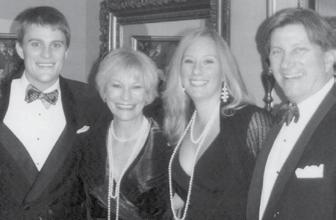
















• Asset Protection
• 401(k) Rollovers
• Retirement
• Estate Planning
• Charitable Giving
• Employee Benefits
• Long Term Care Insurance
• Business Continuation Planning
• Financial Wellness

Helping businesses achieve their financial goals since 1999
Offices conveniently located in Easton, Salisbury,Annapolis and Timonium.







By Jennifer Robin Musiol, C-RNP,Cer tified in Advanced Bio-identical Hormone Replacement Therapy
Do you see declining hormone levels as anatural part of aging? Hormones affect your energy level, your sex life, your ability to maintain muscleand keep weight off, and your ability to think clearly.Why should you have to live with adeclining body and mind? The answer is simple: Youdon’t.
From age 30 onward, testosterone begins to drop one to three percent each year in both men and women. In your 40s, you may start complaining about “feeling older ” Work productivity may decline, you spend more time on the couch and your once-effective workout doesn’tdeliver the same results. (The results in the bedroom may be declining also!)
Careful restoration of the major sex hormones, plus stress reduction, some diet changes and striving for maximal body movement, has given many the vitality they need to enjoy life. New Day Vitality Center (NDV) offers natural bioidentical hormone replacement by using slow-release pellet therapy for women and men.
“Ididn’tthink Ineeded it,” says NDV patient Saroya Sewell. She remembers that she limped into our office last year.“Aftermyfirst insert, Ifelt a vibrancy and aliveness in my body that Ihadn’tfelt for years,” says the 57-year-old. “And Ican walk fast without pain now.”
Remember when your sex drive was healthy,you felt great, slept like ababy andhad more energy than you knew what to do with? Then along comes menopause and her companions: hot flashes, night sweats, irritability,weight gain, sleep disturbances and fatigue. Wouldn’titbenice to turn back the years and regain some of that health and vigor?
New Day VitalityCenter ’s hormone therapy is designed specifically to help you achieve the natural, healthy balance of sex hormones your body needs to maintain optimal well-being. The pellet hormone delivery system actually replenishes what decreases through the aging process, using hormones with the same molecular structure as those your body createdingreater supply when you were healthy and in your prime.

“Idecided to try thistherapy to get ajump on andropause,” says 41-year-old Erich Jessup. “My energy is better,Isleep better and there is adifference in my muscles: more lean and less bulk.”
By restoring your hormone levels, reclaiming your vitality and thriving in ALL your relationships is possible! Call 410-793-5212 today to schedule your free consultation.


Our Q&A with Jaki Steward Hernandez, national spokesman for Operation Christmas Child
By Amelia Blades Steward

Jaki Steward Hernandez was born in Guatemala to a young mother who brought her to a cramped and overwhelmed orphanage when she was only a few months old. Jaki rarely had anything she could call her own. Sharing a room with twelve other girls, she learned how to protect what little she had. One December, when Jaki was five, she and the children in her orphanage received Operation Christmas Child shoebox gifts. For the first time, all the children had toys to play with, and they all had things they could call their own.
Today, Jaki is married and living in Easton with her husband Eduardo. She works at Garden Treasures in Easton. This is the third year she has been a National Spokesperson for Operation Christmas Child, travelling to 25 states speaking to churches, schools, and community organizations and being interviewed by radio and television stations across the country about her experience.
What was special about receiving an Operation Christmas Child Shoebox when you were in the orphanage in Guatemala? It was amazing at age five to know that strangers would take the time to pack this box and didn’t even know me. Getting my first toothbrush knowing I wouldn’t have to share it with 10 girls. Plus, ultimately knowing that the song “Jesus Loves Me” came to life for me with the Operation Christmas Child Shoebox. Some other favorite items in the box were stuffed animals to hug after receiving hugs from the
missionaries who visited us and coloring books and crayons where I didn’t leave one ounce of white paper showing. It was when I received the shoebox that the seed of hope was planted in my life.
Why are you a spokesperson for Operation Christmas now in your life? It is an opportunity to give back to the ministry that impacted my life at such a young age. I love packing shoeboxes now. The boxes I send are always a pink explosion — everything is pink (my


Submitted photos by Jaki Steward Hernandez

“
It was amazing at age five to know that strangers would take the time to pack this box and didn’t even know me.
favorite color!) Meeting volunteers from across the country who make this ministry possible has been very rewarding. It’s humbling no matter where I go, I meet people who have been to Guatemala on mission trips or who are going there in the future. The world gets even smaller when there is that connection.
What makes this ministry unique?
In the 25 years it has been around, the power of prayer in this ministry is what makes
it unique. You see the numbers of boxes increase, but it is hearing the stories of the recipients about the power of prayer in their lives that is so amazing. In addition, all ages can participate in this ministry — from the oldest to the youngest, packing shoeboxes for these children in need. Older volunteers like making the crafts and packing the boxes with their family members so it becomes a multigenerational effort. There is a 101-year old man from Western Maryland who makes wooden cars for the shoeboxes every year.


How do people get involved in Operation Christmas?
The first thing is to visit the website samaritanspurse. org/OCC. Even though the local collection of shoeboxes has already occurred, you can build a shoebox online all year round or you can become a volunteer or prayer partner. You can also begin now and get your organization or church involved in Operation Christmas Child for next year. Most churches start in September to get their efforts going. The third week of November is collection week. Locally, Talbot Bible Church is the collection site, then the shoeboxes are sent to a processing center through mid-December and shipped to children all over the world throughout the year.
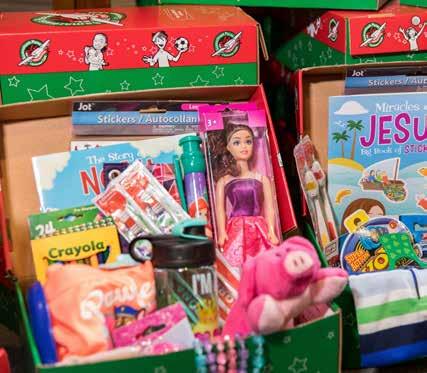


























Talbot Interfaith Shelter unites people from different backgrounds to work toward a common goal: helping their fellow man
Story by Reen Waterman |
While America seems to be bursting apart at the seams due to angry social and political upheaval, the Talbot Interfaith Shelter is an encouraging story of a community uniting in love.
More than people coming together to simply provide shelter, this is a story of a community successfully pulling together, pooling resources and helping restore individuals and families to self-sustaining lives.
This remarkable accomplishment involves selfless people of various faiths (and some of no faith), backgrounds and differences partnering

with the common goal of restoration. Amazingly, more than 450 volunteers serving on 30 daily shifts invest in the rebuilding process for the temporary residents at the shelter.
In 2008, while serving on the Missions Committee of Christ Church, Evelyn Sedlack became deeply concerned with the expanding homeless population in America. She quickly learned that despite Talbot County’s affluence, it also had a growing homeless population.
As Jayme Dingler, marketing and development director for the shelter, said, “Just because you don’t see people panhandling
doesn’t mean we do not have a homeless problem.”
Operations Director Fran Doran said, “While the homeless problem is growing, there are also many more people who are but a ‘snowball’ away from being homeless ... one unexpected car repair bill, medical bill, or loss of job can snowball into homelessness.”
While it is hard to get exact figures on the total homeless population in Talbot County, there are currently 173 students in local schools who are homeless.
Sedlack passionately began rallying people from churches, businesses and restaurants, as well as community leaders, to come together and help the county’s homeless. She used an empowering model for community engagement employed across America.
Opened in January of 2009, today’s shelter began as a rotating shelter among local churches. Fire codes required no more than five guests could be housed overnight in a church without a sprinkler system.
Volunteers fed these guests, drove them to the YMCA for showers, and took them to laundromats. Because the guests had to arrive by 5 p.m. and leave the next morning by 7 a.m., Sedlack’s team realized that church facilities could not adequately meet needs, and accommodating more guests, specifically those with families, was imperative.
Sedlack’s leadership team grew to become the Talbot Interfaith Shelter (TIS), a nonprofit organization with a board of directors. They worked closely with the Talbot County Office of Housing, which performed a feasibility study for the construction of a facility that could house 40 people.
While plans were being drawn by an architect, one of the board members mentioned that his wife was considering selling her bed-andbreakfast. He suggested that this might make an ideal shelter. Board members were in favor of such a plan, and they immediately began raising funds to acquire it.
There were countless testimonies of
generosity demonstrated as the process continued. One anonymous volunteer donated half of the purchase price of the shelter. Others donated funds or clothing, while many became volunteers and mentors. Other individuals met physical needs, such as the time a blind guest broke his white cane, and within 30 minutes of the Shelter’s posting the need on Facebook, someone supplied a cane.
Lives are being changed here, and not just the lives of the homeless. There are many benefits. People are given the opportunity to appreciate other peoples’ faiths, learn cooperation, experience the blessings of “paying it forward,” and simply offer a listening ear, positively impacting those experiencing rough times.
While it is hard to get exact figures on the total homeless population in Talbot County, there are currently 173 students in local schools who are homeless.
Neighbors who were originally opposed to having a shelter move to their street have become fans and volunteers. Children, including local Boy Scouts and Girl Scouts, have become volunteers.
“Kids on a mission are unstoppable,” said Talbot Interfaith Shelter Executive Director Julie Lowe.
Children have bricked pavements, created a garden, forgone birthday presents in order to donate to the shelter, and run lemonade stands to raise money. Best of all, many children volunteers simply do what kids do best, make friends with the children guests.
Going through the approval process to obtain a special exception permit took two years, during which the owners of the facility leased it to TIS. On the very day the two-year lease expired, the use permit was issued. On Nov. 20, 2014 the doors of the official shelter opened.


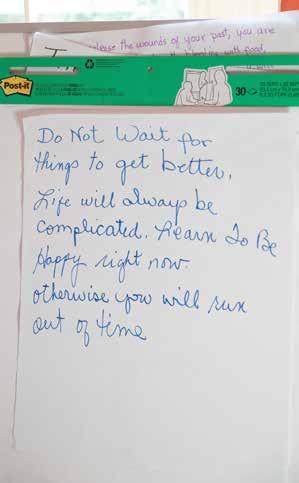

“While we are an interfaith shelter, we specifically keep faith out of the conversations, and no proselytizing happens,” Dingler said. “But I can tell you this ... things magically appear just when we need them, so we know ‘someone’ is watching over us.”
While the facility, having been a bedand-breakfast, does allow guests to experience a home-like atmosphere as they stabilize, Doran’s goal is to restore guests to self-sufficiency. Doran guides staff and volunteers in a coordinated process to help guests transition from trauma to stability, to self-sustaining lives. It is lovingly called “the Fran Plan.”
Doran, who has a master’s degree in healthcare and 20 years of social and healthcare experience, focuses on connecting guests with government and community agencies
while re-establishing their confidence. She oversees classes in parenting, money management, and job interviewing skills.
The Talbot Interfaith Shelter also owns and leases eight apartments on a graduated subsidy basis to guests as they return to the workforce. Longterm goals for the shelter include a million-dollar endowment that would provide consistent revenue generated by a thrift store while teaching practical job skills.
The biggest challenge the shelter faces is not the restoration process, but affordable housing that would enable guests to become self-sufficient. For someone getting back on their feet, affordable rent is crucial. Another hurdle is affordable transportation that would allow guests to acquire and maintain higher paying jobs.
S
Tours of Talbot Interfaith Shelter can be arranged by contacting the shelter, www. talbotinterfaith shelter.org. The website also offers information about volunteering, ongoing financial support, and end-of-year gifts.




And now, please raise your glasses for a

Prepare for New Years in style with delicious sparkling wine pairings that will have your taste buds transported to an elegant evening in Paris
What are you doing New Year’s Eve? If you’re dreaming of toasting the new year in the City of Lights, but your passport has long expired don’t fret mon ami, downtown Cambridge is where you need to be before the clock strikes midnight.
To see if I could re-create a night in Paris, complete with endless bubbly, on the Eastern Shore, I traveled to Chef Ian Campbell’s Bistro Poplar on Poplar Street. Within seconds, I was transported to a formal yet welcoming little bistro much like the ones I spied as I traveled the streets of the 8th arrondissement.
Since I was a party of one, the bar was perfect for me. General Manager Natalie Brewer gleefully greeted me and helped me select the perfect sparkling wine from the well-stocked bar behind her. With my sparkling Simonet Blanc de Blancs brut in hand and images of the Eiffel Tower in my heart, I couldn’t wait to figure out what to pair with it first.
The tapas-style menu is always changing, but customer favorites are always on the menu. As I scanned the menu, Brewer suggested the perfect starter to compliment my sparkling wine, the onion soup gratinée.
“A lot of love goes into it,” Brewer assured me just as was about to dip my spoon into the gruyere. It was true love and then some, I believe, as I spooned the hot broth and caramelized onions in my mouth, only stopping to sip my wine. The full-bodied broth and the tartness of the sparkling brut paired quite nicely and within minutes, I discovered that instead of just tasting the soup, I had devoured the entire dish.
Next up, what’s a night out in Paris without a beautiful display of roasted oysters on a bed of rock salt. I sipped a bit of sparkling wine to cleanse my palate, and I’m glad that I did because the sharpness from the wine really complimented the cheesy, bacon-y, buttery, garlic goodness that coated the
oysters and heightened the surprise kick of the cayenne. I didn’t think I could eat all five of the oysters, but I was surprised by how easy it was.
While I may not always know what tapas pair best with champagne and sparkling wine, I do know that dessert pairs nicely with everything, right?
Thankfully, Brewer was able to point me in the right direction to keep me with my theme or I would’ve ordered every single dessert pastry chef Emily Salisbury created.
Minutes later I was presented with a perfectly round scoop of freshly prepared blackberry lime sorbet. I skimmed the deep purple confection with my spoon and popped a dollop on my tongue. Divine. I then sipped a little of my wine and enjoyed another spoonful, and this time: magic. The bubbles danced around on my tongue and the tangy blackberry played well with the dryness of the wine. Every time I sipped the wine and had a taste of the sorbet, I had my own little magical fireworks in my mouth.
Some believe that French women stay slim because they only have small bites of their meals and very rarely indulge. Well, my goal for the night was to enjoy an evening in Paris with perfect pairings so overindulging was a must. Another must in my book is crème brûlée, but could the creamy cool custard with a brittle sugary crust pair well with a sparkling wine? It was my duty to find out. I tapped the tip of my spoon on the glossy, toasted crust before it made its way to the creamy center. The smooth sweetness was exactly what I needed to finish my meal and the tanginess of wine made the custard even sweeter.
After my make-believe night in Paris, it’s clear that a dry sparkling wine or Champagne pairs well with most any French delicacy. It’s also clear that without frequent flier miles or a passport, a little bit of France is never far as long as you have a great glass of bubbly. I now know what I’m doing on New Years Eve.
S





HOLIDAY SOCKS
The Christmas Shop 216 S Talbot Street, St. Michaels, MD 21663 (410) 745-9346




7 S. Washington St., Easton. MD 21601 (410) 822-7716 www.crackerjackstoys.com






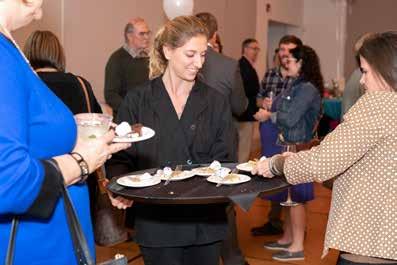





Shore Monthly celebrated one year of publication in October at the Academy Art Museum in Easton.
by Arden Haley














Wilson Clough, son of Amy Clough, enjoys some of her decorated sugar cookies, at the Preston Lions’ Club, a community organization. Visit Clough’D 9 Cookies at www.cloughd9cookies.com or email cloughd9cookies@gmail.com or Clough’D 9 Cookies is also on Facebook and Instagram.




November 30
MoonlightMadness,Easton
Handmade from the Hear t, Evergreen Center,Easton
November 30–December 2
Ar t& Craf tMarketplace, Waterfowl Building,Easton
Christmas on the Creek,Oxford
December 1
Easton HolidayParade
St.Michaels MidnightMadness
Peterand Will Anderson Jazz Concer t, Oxford CommunityCenter
Motown and More —A HolidayCelebration, Avalon Theatre, Easton
December 1–31
HolidayCarriage Rides,TidewaterInn, Easton
December 2
BaltimoreMandolin Orchestra, Avalon Theatre, Easton
Breakfast with Santa, TidewaterInn, Easton
December 7
First Weekend,Easton
Glenn Miller Orchestra HolidayShow, Avalon Theatre
December 7–9
Christmas in St.Michaels
December 8
GreatCrabPot Christmas Tree Lighting and Boat Parade,Tilghman Island
December 8–9
Sip and Shop,TripleCreek Winer y, Cordova
December 9
Avalon at ChesapeakeCollege Series: An Evening with America, Todd Performing Ar ts Center,Wye Mills
December 12–13
Skate with Santa, Talbot County CommunityCenter, Easton
December 14–23
Annie theMusical,AvalonTheatre, Easton
December 15
WinterSolsticeConcer t, Oxford Community Center
December 31
25th Anniversar yCelebration of First Night Talbot,Easton






